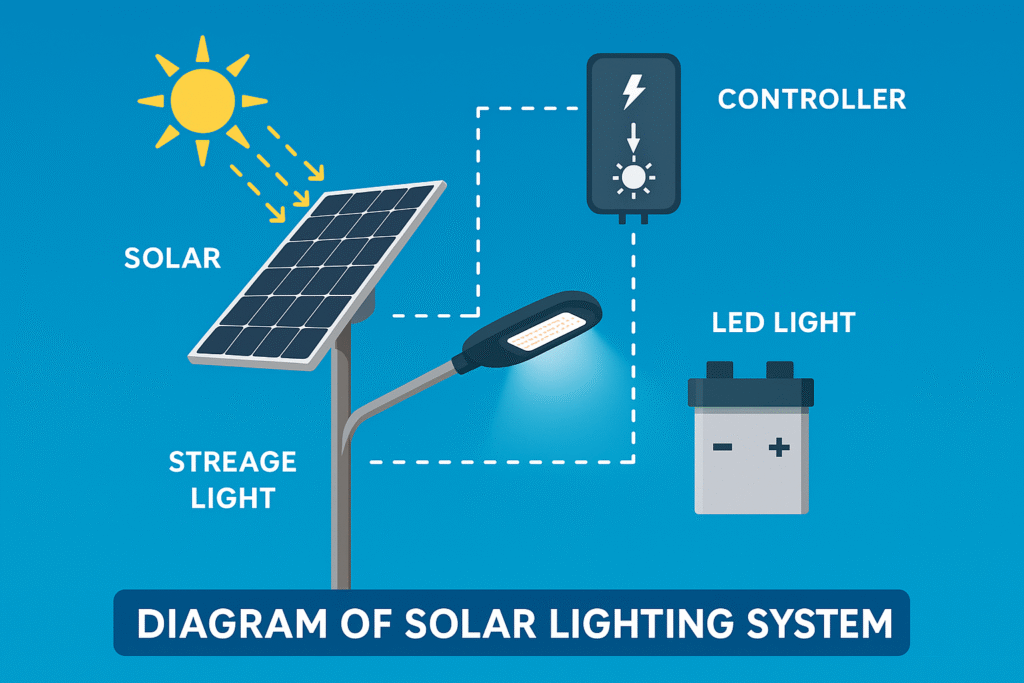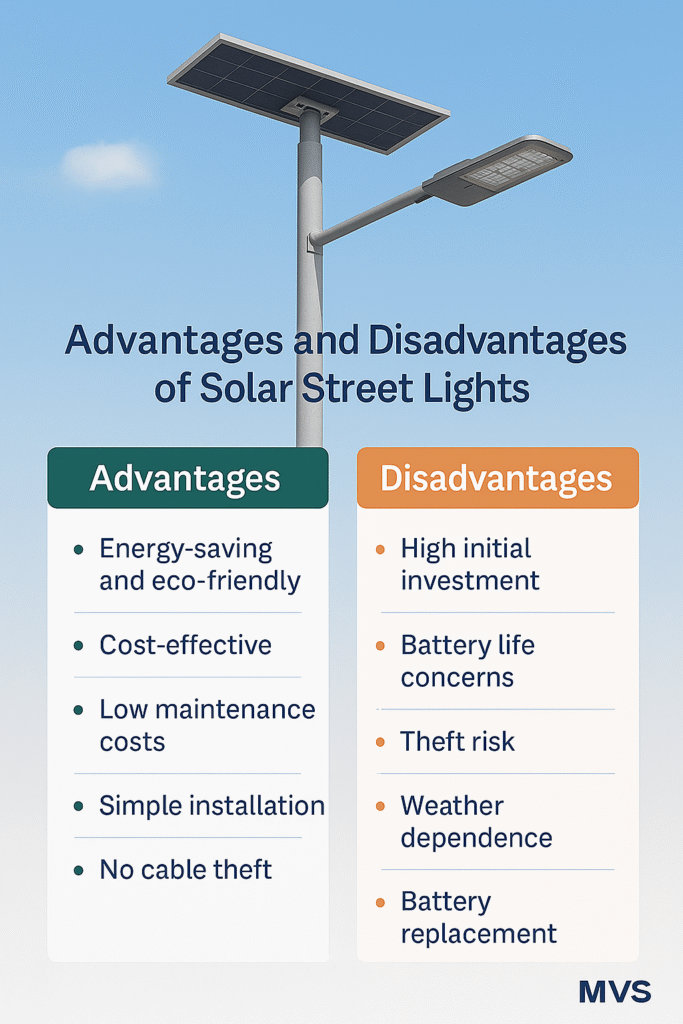Introduction
As cities and infrastructure developers aim to build greener, smarter communities, solar LED street lights are becoming an increasingly attractive solution. Combining the benefits of solar energy and LED technology, these systems offer long-term cost savings and environmental advantages.
However, procurement officers must fully understand both the advantages and disadvantages before committing to a large-scale deployment.
In this article, we break down everything you need to know to make a well-informed procurement decision for your next outdoor lighting project.

How Solar LED Street Lights Work
A solar LED street light system consists of four main components:
- Solar panel: Captures sunlight and converts it into electricity through the photovoltaic effect.
- Rechargeable battery: Stores the generated energy for use at night.
- LED light source: Provides high-efficiency, low-power illumination.
- Smart controller (MPPT or PWM): Manages the charging, discharging, and protective functions to optimize system performance.
Many modern solar street lights integrate smart controls such as motion sensors, adaptive dimming, and remote monitoring — essential features for smart city lighting projects.

Advantages of Solar LED Street Lights
Energy Efficiency and Cost Savings
Solar LED street lights can deliver up to 70% energy savings compared to traditional sodium vapor lamps.
While the initial investment is higher, the long-term savings in energy costs and maintenance expenditures more than offset the upfront costs over a typical 10–15 year lifecycle.
Learn more about energy-saving outdoor lighting solutions.
Environmental Sustainability
Solar LED systems operate with zero carbon emissions and do not involve hazardous materials like mercury.
This makes them an ideal choice for municipalities aiming to meet ESG (Environmental, Social, and Governance) targets and promote sustainability.
Installation Flexibility and Infrastructure Savings
Because they operate off-grid, solar LED lights do not require trenching, cabling, or grid connection.
This significantly reduces installation time, project disruption, and civil works costs, especially in remote areas.
Durability and Resilience
With an average lifespan of 50,000+ hours, LEDs offer outstanding reliability.
In case of power outages, solar street lights continue functioning independently, ensuring consistent public safety.
Smart City Integration
Solar LED street lights are easily integrated with smart city platforms, allowing for:
- Real-time monitoring
- Adaptive dimming
- Predictive maintenance
These features enhance urban energy efficiency and public service reliability.

Disadvantages of Solar LED Street Lights
High Initial Investment
The upfront cost of solar LED lighting systems can be 3–4 times higher than conventional street lighting.
Procurement teams must conduct Total Cost of Ownership (TCO) analysis to justify the investment over the long term.
For detailed TCO calculations, check our LED Lighting Project Cost Guide.
Battery Lifespan and Replacement
Batteries typically require replacement every 5–7 years, depending on usage and weather conditions.
Choosing LiFePO₄ (lithium iron phosphate) batteries instead of traditional lead-acid types significantly reduces maintenance costs and environmental risks.
Sunlight and Weather Dependency
Solar performance is highly dependent on geographical location and weather conditions.
Extended periods of cloudiness, rain, or snow can reduce energy generation, impacting light availability at night.
Risk of Theft and Vandalism
Solar panels and batteries are valuable assets, making them attractive to thieves, especially in unsecured areas.
Solutions include integrated anti-theft designs, battery burial methods, and remote alarm systems.
Maintenance Challenges in Harsh Environments
In regions prone to dust storms, heavy snow, or extreme weather, solar panels require regular cleaning and inspection to maintain optimal efficiency.
Key Procurement Considerations
Product Quality and Certification
Only procure solar LED lights that meet recognized standards such as CE, RoHS, IEC, and ISO9001.
Request detailed technical specifications, third-party test reports, and project references.
Battery and Solar Panel Specifications
Focus on:
- High-efficiency solar panels (≥20% efficiency)
- Durable batteries (LiFePO₄ preferred)
- 5+ year warranties for both components
Customization Options
Select products that allow:
- Brightness adjustment
- Smart control upgrades
- Climate-resilient configurations tailored to local conditions
Learn more about customizing outdoor lighting solutions.
Vendor Evaluation and Risk Management
Work with suppliers who offer:
- Documented project experience
- Strong after-sales support
- Available spare parts and maintenance training
Be cautious of low-cost suppliers who cut corners on battery quality, panel efficiency, or control system reliability.
Frequently Asked Questions (FAQ)
What are the pros and cons of LED street lights?
- Pros: High energy efficiency, long lifespan, lower maintenance needs, smart technology compatibility.
- Cons: Higher upfront investment, potential glare issues if not properly designed, temperature sensitivity in extreme climates.
What are the cons of solar street lights?
- High initial costs, dependency on sunlight, periodic battery replacement, vulnerability to theft, and maintenance challenges in harsh weather conditions.
What are the pros and cons of solar lights?
- Pros: Renewable energy usage, no electricity bills, eco-friendly, flexible deployment.
- Cons: Weather-dependent performance, higher upfront costs, maintenance of batteries and panels over time.
How do I choose the best solar street light?
- Ensure certification compliance (CE, RoHS, IEC).
- Select high-efficiency solar panels and LiFePO₄ batteries.
- Consider project-specific features like motion sensors, smart dimming, and modular designs.
- Evaluate the supplier’s experience and after-sales support offerings carefully.
Conclusion
Solar LED street lights represent an outstanding opportunity to reduce operational costs, support sustainability goals, and enhance urban resilience.
However, a successful procurement requires careful evaluation of technical performance, total cost of ownership, and long-term maintenance strategies.
When deployed strategically, solar LED street lights are a powerful step forward toward smarter, greener cities.
Ready to explore customized solar LED street lighting solutions?
Visit MVS Lighting Solutions for expert guidance and project support.

